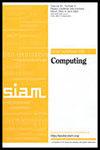在[数学]范围内从非黑箱最坏情况到平均情况的减少量
IF 1.6
3区 计算机科学
Q3 COMPUTER SCIENCE, THEORY & METHODS
引用次数: 0
摘要
SIAM 计算期刊》,第 52 卷第 6 期,第 FOCS18-349-FOCS18-382 页,2023 年 12 月。 摘要要在[math]的最坏情况和平均情况硬度之间建立等价关系存在重大障碍。一些结果表明,黑箱最坏情况到平均情况的还原不可能用于将[math]之外的任何最坏情况问题还原为分布式[math]问题。本文克服了这一障碍。我们提出了第一个非黑箱的从最坏情况到平均情况的还原法,将一个猜想在[数学]之外的问题还原为一个分布式[数学]问题。具体来说,我们考虑了最小时界科尔莫哥洛夫复杂度问题(MINKT),并证明如果其平均情况版本允许一个无差错启发式多项式时间算法,则存在一个零错误随机多项式时间算法,可以在加法误差[数学]内逼近最小时界科尔莫哥洛夫复杂度[数学]。我们观察到,MINKT 的近似版本是随机 3SAT 难,更一般地说,它比避免任何用[math]扩展其种子长度[math]的多项式时间可计算命中集生成器更难,这有力地证明了近似问题在[math]之外,因此我们的还原是非黑箱的。我们的还原可以去随机化,但要以近似的质量为代价。我们还证明,给定一个大小为 [math] 的真值表,如果其平均情况版本很容易,那么对于某个常数 [math],在 [math] 的一个因子内逼近最小电路大小就在 [math] 内。我们的结果可以看作是排除启发式的一种新方法。特别是,证明 MINKT 或最小电路规模问题的近似版本的 [math] 难度,就足以建立 [math] 的最坏情况难度和平均情况难度之间的等价关系。本文章由计算机程序翻译,如有差异,请以英文原文为准。
Non-Black-Box Worst-Case to Average-Case Reductions Within [math]
SIAM Journal on Computing, Volume 52, Issue 6, Page FOCS18-349-FOCS18-382, December 2023.
Abstract. There are significant obstacles to establishing an equivalence between the worst-case and average-case hardness of [math]. Several results suggest that black-box worst-case to average-case reductions are not likely to be used for reducing any worst-case problem outside [math] to a distributional [math] problem. This paper overcomes the barrier. We present the first non-black-box worst-case to average-case reduction from a problem conjectured to be outside [math] to a distributional [math] problem. Specifically, we consider the minimum time-bounded Kolmogorov complexity problem (MINKT) and prove that there exists a zero-error randomized polynomial-time algorithm approximating the minimum time-bounded Kolmogorov complexity [math] within an additive error [math] if its average-case version admits an errorless heuristic polynomial-time algorithm. We observe that the approximation version of MINKT is Random 3SAT-hard, and more generally it is harder than avoiding any polynomial-time computable hitting set generator that extends its seed of length [math] by [math], which provides strong evidence that the approximation problem is outside [math] and thus our reductions are non-black-box. Our reduction can be derandomized at the cost of the quality of the approximation. We also show that, given a truth table of size [math], approximating the minimum circuit size within a factor of [math] is in [math] for some constant [math] iff its average-case version is easy. Our results can be seen as a new approach for excluding Heuristica. In particular, proving [math]-hardness of the approximation versions of MINKT or the minimum circuit size problem is sufficient for establishing an equivalence between the worst-case and average-case hardness of [math].
Abstract. There are significant obstacles to establishing an equivalence between the worst-case and average-case hardness of [math]. Several results suggest that black-box worst-case to average-case reductions are not likely to be used for reducing any worst-case problem outside [math] to a distributional [math] problem. This paper overcomes the barrier. We present the first non-black-box worst-case to average-case reduction from a problem conjectured to be outside [math] to a distributional [math] problem. Specifically, we consider the minimum time-bounded Kolmogorov complexity problem (MINKT) and prove that there exists a zero-error randomized polynomial-time algorithm approximating the minimum time-bounded Kolmogorov complexity [math] within an additive error [math] if its average-case version admits an errorless heuristic polynomial-time algorithm. We observe that the approximation version of MINKT is Random 3SAT-hard, and more generally it is harder than avoiding any polynomial-time computable hitting set generator that extends its seed of length [math] by [math], which provides strong evidence that the approximation problem is outside [math] and thus our reductions are non-black-box. Our reduction can be derandomized at the cost of the quality of the approximation. We also show that, given a truth table of size [math], approximating the minimum circuit size within a factor of [math] is in [math] for some constant [math] iff its average-case version is easy. Our results can be seen as a new approach for excluding Heuristica. In particular, proving [math]-hardness of the approximation versions of MINKT or the minimum circuit size problem is sufficient for establishing an equivalence between the worst-case and average-case hardness of [math].
求助全文
通过发布文献求助,成功后即可免费获取论文全文。
去求助
来源期刊

SIAM Journal on Computing
工程技术-计算机:理论方法
CiteScore
4.60
自引率
0.00%
发文量
68
审稿时长
6-12 weeks
期刊介绍:
The SIAM Journal on Computing aims to provide coverage of the most significant work going on in the mathematical and formal aspects of computer science and nonnumerical computing. Submissions must be clearly written and make a significant technical contribution. Topics include but are not limited to analysis and design of algorithms, algorithmic game theory, data structures, computational complexity, computational algebra, computational aspects of combinatorics and graph theory, computational biology, computational geometry, computational robotics, the mathematical aspects of programming languages, artificial intelligence, computational learning, databases, information retrieval, cryptography, networks, distributed computing, parallel algorithms, and computer architecture.
 求助内容:
求助内容: 应助结果提醒方式:
应助结果提醒方式:


